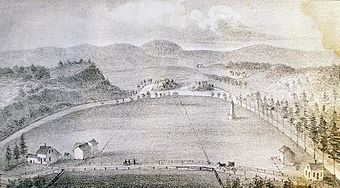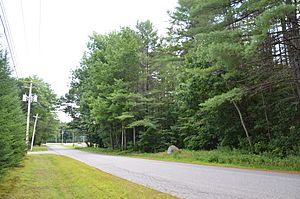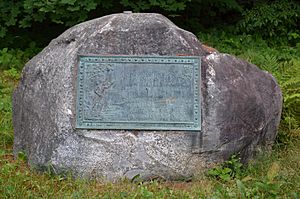Norridgewock facts for kids
|
Norridgewock Archeological District
|
|

Old Point in 1849
|
|
| Location | Norridgewock, Starks, and Madison, Maine |
|---|---|
| Built | 1625 |
| NRHP reference No. | 93000606 |
Quick facts for kids Significant dates |
|
| Added to NRHP | April 12, 1993 |
| Designated NHLD | April 12, 1993 |
Norridgewock was the name of an important Native American village and a group of the Abenaki people. The Abenaki are also known as the "People of the Dawn." They are a Native American tribe from the Eastern Algonquian group.
The French, who settled in New France (now Canada), called the village Kennebec. The Norridgewock tribe lived in what is now central Maine. During the time when Europeans were settling North America, this area was claimed by both British and French colonists. It was located along the western edge of Acadia, a French territory.
Today, archaeologists have found several sites linked to the Norridgewock settlement. The most famous site is called Old Point, located in Madison. This is where the French Jesuit priest Sebastian Rale had his mission. Other important sites are found nearby in Starks and the modern town of Norridgewock. These three historically important areas are now protected as the Norridgewock Archaeological District. It is a special place recognized as a National Historic Landmark District.
Contents
The Norridgewock Village
The name Norridgewock comes from the word Nanrantsouak. It means "people of the still water between the rapids." Their main village, also called Norridgewock, was built on a flat area. This area was inside a wide bend of the Kennebec River, across from where the Sandy River joins it.
In 1716, a surveyor named Joseph Heath described the village. He said it was a square fort surrounded by a strong wooden fence, called a palisade. This fence was about 9 feet (2.7 meters) tall. Each side of the fort was 160 feet (49 meters) long. There was a gate in the middle of each side.
Inside the fort, two streets connected the gates. They formed an open square in the center, marked by a large cross. The fort held 26 cabins, which were likely made of logs. Canoes were kept along the river, and paddles were stored inside the cabins.
The Norridgewock people had large fields nearby. They grew maize (corn), wheat, beans, pumpkins, and squash. Twice a year, in summer and winter, the tribe would go to the seashore. There, they would catch fish, seals, clams, oysters, and seafowl (sea birds).
France and England both wanted control of the Kennebec River area. France wanted it because the river could be a path to attack Quebec. English colonists claimed land based on deeds they had. However, the Native American chiefs who signed these deeds often thought they were only giving permission to use the land for hunting or safe travel. The French argued that the chiefs could not sell land because it belonged to the whole tribe.
Even when France and England were at peace, the French secretly encouraged Native Americans to stop English settlers from expanding. French Jesuit missionaries lived among the Abenaki. They were loyal to both their church and the French king. Norridgewock Village was seen as a key outpost for Quebec.
In 1694, Father Sébastien Rale came to Norridgewock. He started a Jesuit mission, which was the first school in Maine. He built a small chapel in 1698. Even though some tribal medicine men disagreed, Father Rale helped most of the villagers become Catholic. The chapel burned down in 1705, but a new church was built in 1720. It was a large log building, about 60 feet (18 meters) long and 25 feet (7.6 meters) wide. Forty Abenaki youths helped in the church.
Father Rale spoke the Abenaki language very well. He became deeply involved in the tribe's life. He had a strong influence over the Abenaki people. This made the Protestant British colonists suspicious. They thought he was encouraging the tribe to be hostile towards them.
King William's War
During King William's War, there was a conflict known as the "Oyster River Massacre." On July 18, 1694, a French soldier named Claude-Sébastien de Villieu led about 250 Abenaki warriors from Norridgewock. Their chief, Bomazeen, was in command. They attacked the English settlement of Durham, New Hampshire.
In this raid, 45 English settlers were killed, and 49 were taken captive. Half of the village was burned, including five fortified houses called garrisons. The attackers also destroyed crops and killed all the farm animals. This caused great hardship for the people who survived.
Queen Anne's War
When Queen Anne's War began, France and England were again fighting over land. Massachusetts Governor Joseph Dudley met with tribal leaders in 1703. He asked them to stay neutral, meaning not to pick a side. However, the Norridgewock tribe chose to join the French.
In August 1703, the Norridgewock tribe joined a larger group of French and Native American fighters. They were led by Alexandre Leneuf de Beaubassin. They attacked Wells as part of the Northeast Coast Campaign (1703). Many believed Father Rale was encouraging the tribe to fight the English. He felt the English settlements were taking Abenaki land.
Governor Dudley offered a reward for Father Rale's capture. In the winter of 1705, 275 English soldiers, led by Colonel Winthrop Hilton, were sent to capture Rale and destroy the village. Father Rale was warned and escaped into the woods. The soldiers then burned the village and the church.
Raid on Wells (1703)
As part of the 1703 campaign, about 500 Native Americans, including those from Norridgewock, and some French soldiers attacked Wells. This attack happened on August 10 and 11, 1703.
Raid on Norridgewock (1705)
In response to the attacks, a reward was placed on Father Rale. In the winter of 1705, Colonel Winthrop Hilton led 275 English soldiers to Norridgewock. The village was empty because its people, including Rale, had been warned. Colonel Hilton ordered his soldiers to burn the village and the church.
After these conflicts, peace was made between France and England with the Treaty of Utrecht and Treaty of Portsmouth (1713). France agreed to give Acadia to the English. However, the exact border of Acadia was still unclear. This disagreement between Quebec and Massachusetts continued until the Treaty of Paris in 1763.
In 1713, the Norridgewocks sought peace with the English at the Treaty of Portsmouth. They agreed to have English trading posts on their land. It was easier to trade furs for goods with the English, as it was a shorter trip than going to Quebec.
Father Rale's War
The Norridgewock people's acceptance of English settlers changed. Father Rale encouraged the tribe to resist the growing number of English homes and forts. He taught the Abenaki that their land should be kept safe for future generations.
On July 28, 1721, 250 Abenaki warriors in 90 canoes went to Georgetown. They delivered a letter to Governor Samuel Shute. The letter demanded that English settlers leave Abenaki lands. It warned that if they did not, they would be attacked and their settlements destroyed.
Raid on Norridgewock (1722)
In response, Norridgewock was attacked in January 1722. About 300 English soldiers, led by Colonel Thomas Westbrook, raided the village. They found it almost empty, with the gates open. The tribe was away hunting. The soldiers searched for Father Rale but only found his papers. These papers included letters from New France Governor-general Vaudreuil. The letters promised ammunition for Abenaki raids on English settlements.
The tribe fought back by attacking English settlements downriver on the Kennebec. They burned Brunswick on June 13, 1722. Father Rale sometimes joined these raids. On July 25, 1722, Massachusetts Governor Samuel Shute officially declared war on the eastern Native American tribes.
Battle of Norridgewock (1724)
During Father Rale's War, Norridgewock was attacked for the last time. This happened on August 23, 1724. A group of 208 English soldiers left Fort Richmond. They split into two groups. About 80 soldiers, including three Mohawks, were led by Captain Jeremiah Moulton.
His soldiers quietly approached the village, which no longer had a stockade. A surprised Native American coming out of a cabin shouted a warning. Norridgewock women and children ran from their homes. They swam or waded across the river and fled into the woods. About 60 warriors fired their guns, but they did little harm.
The English soldiers had been ordered to wait until the enemy fired first. Then, they aimed and fired with deadly results. The warriors fired again, then fled across the river. Twenty-six warriors were killed, and 14 were wounded. Bomazeen, the chief who had led the Oyster River Massacre in 1694, was shot while crossing the Kennebec River. An old chief named Mogg shot one of the Mohawks, whose brother then shot Mogg.
Meanwhile, Father Rale was firing at the soldiers from a cabin. He refused to surrender and was shot while reloading his gun.
The soldiers took some gunpowder, guns, blankets, and kettles. Then they returned to their boats. One of the Mohawks, a brave named Christian, went back to set the village and church on fire. Then he rejoined the soldiers. The 150 survivors of Norridgewock returned the next day to bury their dead. Most of them then left the area and moved to Saint-François and Bécancour in Quebec. A few years later, many survivors returned to the Upper Kennebec. A Jesuit missionary, Jacques de Sirenne, was sent to care for them.
Legacy of Norridgewock
The story of Norridgewock Village is featured in the 1836 poem Mogg Megone by John Greenleaf Whittier.
Archaeologists have studied the Old Point area. They have found three different sites linked to the name "Norridgewock." The main site at Old Point has been well-known for a long time. It was added to the National Register of Historic Places in 1973. This recognized both the site and a special marker placed there in 1833.
A second site, called Tracy Farm, is about 500 meters (1,640 feet) north of where the Sandy and Kennebec Rivers meet in Starks. This site was first dug up by experts in 1983. The things found there matched old descriptions of early Norridgewock. In 1990, a large excavation collected 15,000 artifacts from the Late Woodland period and early contact with Europeans. They also found where at least one longhouse once stood.
Another site, closer to where the two rivers meet in Starks, also showed signs of people living there during the Late Woodland period. This site showed signs of repeated flooding. This suggests that people later moved their homes to the higher ground at Tracy Farm and Old Point. These three sites together were named a National Historic Landmark District and added to the National Register of Historic Places in 1993.
See also
 In Spanish: Norridgewock para niños
In Spanish: Norridgewock para niños







